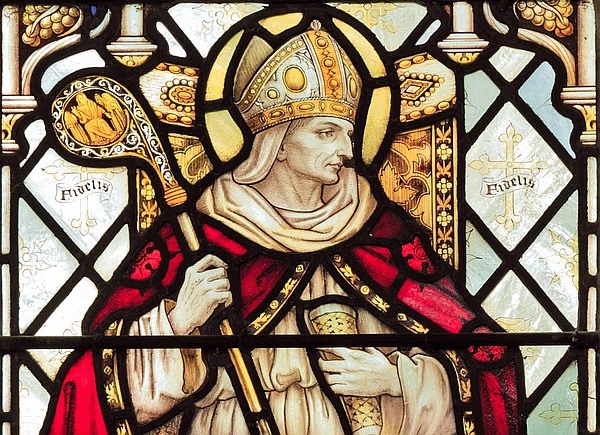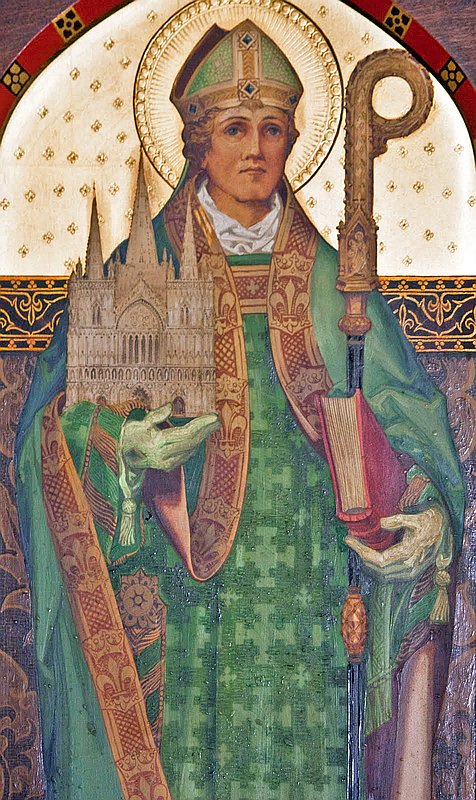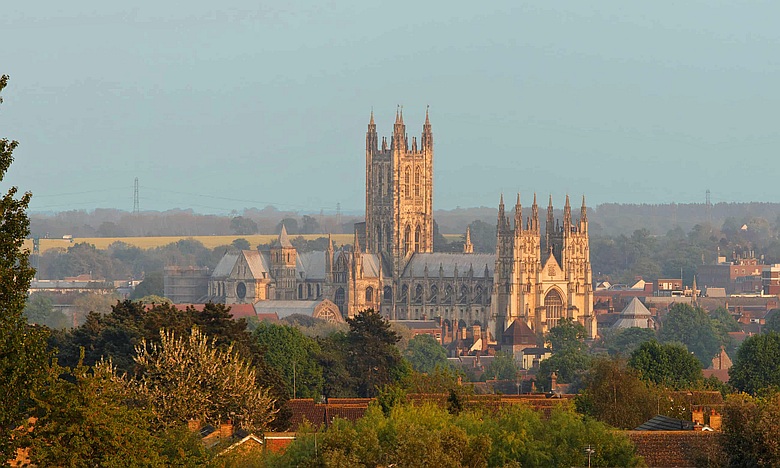

After the death of St. Deusdedit, Archbishop of Canterbury, King Oswi of Northumberland and King Egbert of Kent sent a virtuous and learned priest – named Wighard – to Rome, that he might be consecrated Bishop and duly confirmed to that important See by the Pope himself. Wighard and most of those who attended him died in Italy of the plague; and Pope Vitalian chose instead Adrian, Abbot of Niridian, near Naples, to be raised to that dignity. This Abbot was by birth an African. He understood Greek and Latin perfectly, and was thoroughly versed in theology, as well as in monastic and ecclesiastical discipline. But so great were his fears of the dignity to which he was called, that the Pope was compelled by his entreaties and tears to yield to his excuses. He insisted, however, that Adrian should find a person equal to that charge, and should himself attend upon and assist him in instructing the inhabitants of this remote island in the perfect discipline of the Church.
How edifying and happy was this contention – not to obtain, but to shun such a dignity. Adrian first named to the Pope a monk called Andrew; but he was judged incapable of the necessary fatigues on account of his bodily infirmities, though otherwise a person extremely well qualified. There was then at Rome a Greek monk named Theodore, aged sixty-six, a native of Tarsus in Cilicia (within modern-day Turkey), a man of exemplary life, and well skilled in divine and human learning, and in the Greek and Latin languages. Adrian presented him to the Pope and procured that he should be made a Bishop, promising to bear him company into England.
Theodore, being ordained subdeacon, waited four months for his hair to grow so that it might be shaved in the form of a crown; for the Greek monks shaved their heads all over. At length Pope Vitalian consecrated him bishop on Sunday, March 26, 668, and recommended him to St. Benedict Biscop, who had then come a third time to Rome. The Pope obliged St. Benedict to return to Rome with St. Theodore and Abbot Adrian, in order to be their guide and interpreter. They set out on May 27, went by sea to Marseilles, and from thence by land to Arles, where they were hosted by Archbishop John. St. Theodore passed the winter at Paris with Bishop Agilbert, who had formerly been bishop of Winchester in England. By his conversation the new Archbishop informed himself of the circumstances and necessities of the church, the charge of which he was going to take upon himself. He also studied to learn the English language.
Egbert, King of Kent, hearing that his new Archbishop had arrived at Paris, sent one of the lords of his court to meet him, who accompanied St. Theodore to the port of Quentovic, in Ponthieu – later called Etaple, near St. Josse-sur-Mer. St. Theodore falling sick was obliged to stay there some time. As soon as he was able to travel, he proceeded on his voyage with St. Benedict Biscop and took possession of his See of Canterbury on May 27, 669. Adrian was detained in France some time by Ebroin, mayor of the palace, who suspected that he was sent by the Emperor (Constantine IV) to the Kings of England on some designs against the French. He stayed a considerable time, first with Emmo, Archbishop of Sens, and afterwards with St. Faro, Bishop of Meaux. Ebroin being at last satisfied, Adrian was permitted to follow St. Theodore, by whom he was made Abbot of St. Peter's at Canterbury.
St. Theodore made a general visitation of all the churches of the English nation, taking with him Abbot Adrian. He was everywhere well received and heard with attention; wherever he came, he established sound morality, confirmed the discipline of the Catholic Church – especially in the celebration of Easter, and introduced everywhere Gregorian Chant in the Divine Office and Mass – till then known in few of the English churches, except those of Kent. He regulated all other things belonging to the divine service, reformed abuses, and consecrated bishops in all places where he thought they were wanting.
 Many of the abuses our Saint had to deal with were occasioned by the plague, which decimated the clergy and hierarchy. St. Deusdedit,
Archbishop of Canterbury, was a victim of the plague, and in his absence canon law was not always easy to fulfill. St. Bede the
Venerable tells us that at this time, it was hard to find any bishop in Britain who was canonically ordained. Thus, when St. Wilfrid
was chosen to be Bishop of York, he had to travel to France to be consecrated. During his long absence, the king decided on another
to be Bishop of York, St. Chad (image left), who in fact conducted himself admirably as such. When St. Theodore encountered this
situation, he judged that St. Chad's nomination and consecration had been irregular, and that St. Wilfrid should be recognized as the
Bishop of York. St. Chad replied that he had been nominated and consecrated against his own inclinations, confessed himself unworthy
of such a dignity, and retired with joy to his monastery of Lastingham. Impressed with St. Chad's obvious humility and other virtues,
St. Theodore later installed him as Bishop of Lichfield in Mercia.
Many of the abuses our Saint had to deal with were occasioned by the plague, which decimated the clergy and hierarchy. St. Deusdedit,
Archbishop of Canterbury, was a victim of the plague, and in his absence canon law was not always easy to fulfill. St. Bede the
Venerable tells us that at this time, it was hard to find any bishop in Britain who was canonically ordained. Thus, when St. Wilfrid
was chosen to be Bishop of York, he had to travel to France to be consecrated. During his long absence, the king decided on another
to be Bishop of York, St. Chad (image left), who in fact conducted himself admirably as such. When St. Theodore encountered this
situation, he judged that St. Chad's nomination and consecration had been irregular, and that St. Wilfrid should be recognized as the
Bishop of York. St. Chad replied that he had been nominated and consecrated against his own inclinations, confessed himself unworthy
of such a dignity, and retired with joy to his monastery of Lastingham. Impressed with St. Chad's obvious humility and other virtues,
St. Theodore later installed him as Bishop of Lichfield in Mercia.
St. Theodore was the first Archbishop of Canterbury after St. Augustine to rule over the whole Church in England. He was founder of a most famous school at Canterbury, which produced many great men. St. Theodore and Adrian themselves expounded the Scriptures and taught all the sciences, particularly the ecclesiastical astronomy and arithmetic necessary for calculating the date of Easter each year; also how to compose Latin verses. Many under them became as perfect in Latin and Greek as they were in their own tongue.
Britain had never been in so flourishing a condition as at this time since the English (Anglo-Saxons) first set foot on the island. The kings were so brave, says St. Bede, that all the barbarous nations dreaded their power; but withal such good Christians, that they aspired only after the joys of the Kingdom of Heaven, which had been only recently preached to them. All men's minds seemed only bent on the goods of the life to come, to use the words of the venerable historian.
St. Theodore established schools in most parts of England, and it is hard to say whether we ought most to admire the zeal and unwearied labors of the pastors, or the docility, humility, and insatiable ardor of the people, with whom to hear, to learn, and to practice seemed one and the same thing.
In 670 St. Theodore held a national council at Heorutford, which many take to be Hertford, though it seems more probably to have been Thetford. In this council, Bisi, Bishop of the East-Angles, sat next to the Archbishop. It is affirmed in one the canons that no man leave his wife, unless in the case of adultery; and that even in this case, a true Christian ought not to marry another – proof that this has always been the teaching of the Church. The Eutychian and Monothelite heresies having made a great havoc in the East, St. Theodore held another synod, in 680, at Hetfield, now called Bishop's Hatfield, in which the Mystery of the Incarnation was expounded, the first five General Councils were received, and the above mentioned heresies condemned.
In 678, at the request of King Egfrid, St. Theodore divided the See of York into three dioceses, and installed that many bishops in place of St. Wilfrid, who would have no part in that project. In the following year, St. Theodore consecrated St. Erconwald Bishop of London. War breaking out between Egfrid, King of the Northumbers and Ethelred, King of the Mercians, a great battle was fought near the Trent, in which Elfwing, the amiable younger brother of Egfrid was slain. Upon this news St. Theodore, relying upon the divine assistance, immediately set out to extinguish the flame of war which both kings were bent on prolonging with greater fury than before the engagement; but the authority of the good Bishop, and the religious motives which he made use of, disarmed them at once. Our Saint was so happy as to cement a firm and cordial peace between the two nations, upon no other condition than that of paying the usual restitution to King Egfrid for the loss of his brother.
Few things have rendered the name of St. Theodore more famous than his Penitential or Code of Canons, prescribing the term of public penance for penitents, according to the quality and enormity of their sins. In this Penitential it is stated that when a monk died, Holy Mass was offered for him on the day of his burial, on the third day after, and as often again as the abbot thought proper; also that the Holy Sacrifice was offered for the laity and accompanied by fasting. Here again we have proof that the Catholic doctrines concerning Purgatory, and that the Mass is a propitiatory Sacrifice offered for the living and dead, have always been held.
St. Theodore, being more than eighty years old and seized with frequent bouts of illness, was desirous to be reconciled with St. Wilfrid. He therefore requested the exiled holy prelate to come to him at London, begged his pardon for having consented with the kings to his deprivation, without any fault on his side, did all he could to make amends, and restored him to his See of York. For this purpose he wrote strong letters to Alfrid, King of Northumberland – who had succeeded his brother Egfrid, to Ethelred, King of the Mercians, and to others who were opposed to St. Wilfrid or were interested in this affair; and he had the comfort of seeing his endeavors everywhere successful.

Canterbury Cathedral
St. Theodore was Archbishop of Canterbury for twenty-two years and died in 690, at the age of eighty-eight years. His memory is honored on September 19, which was that of his death. He was buried in the monastery of St. Peter, which afterwards took the name of St. Augustine.
Alphabetical Index; Calendar List of Saints
Contact us: smr@salvemariaregina.info
Visit also: www.marienfried.com